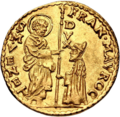This article has multiple issues. Please help improve it or discuss these issues on the talk page . (Learn how and when to remove these messages)
|

The cavallo was a copper coin of Southern Italy in the Italian Renaissance. It was minted for the first time by King Ferdinand I of Naples in 1472. It gained its name from the figure of a horse on the reverse.
